#african mudskipper
Explore tagged Tumblr posts
Note
African mudskipper?? They’re very cool

fish 304 - african mudskipper
#fish#fish daily#african mudskipper#drawing#love these guys theyre so goofy looking#also sorry for no fish lately work has been killing me#and my other autism brainrot is striking again (trains) pensive emoji#girl help
141 notes
·
View notes
Text
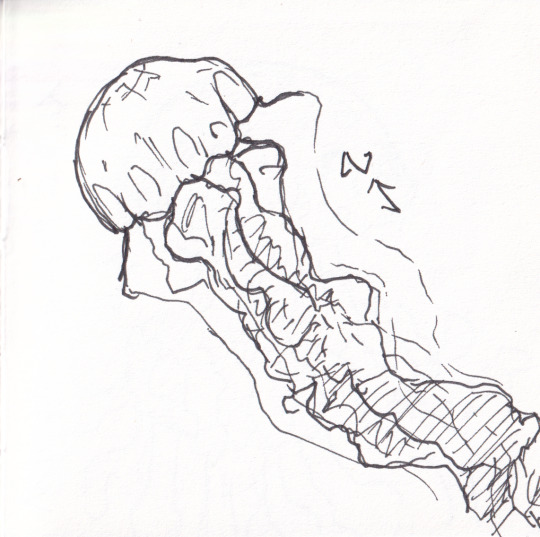



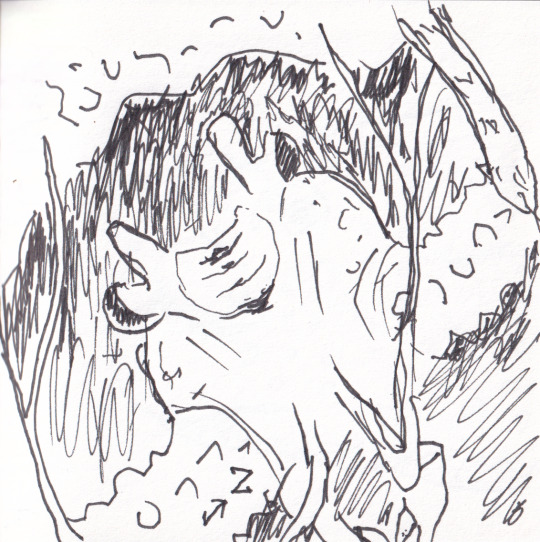
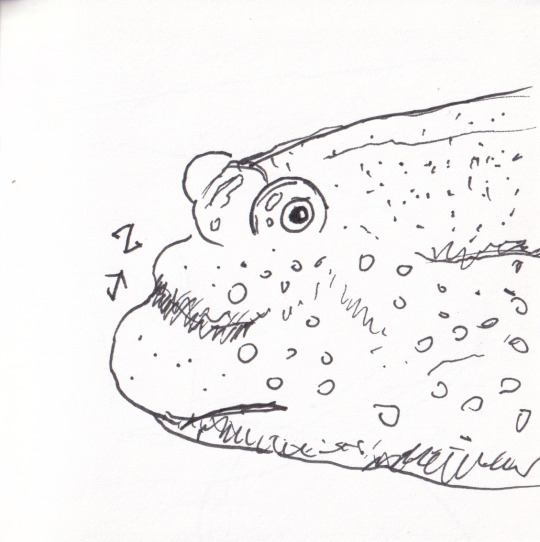
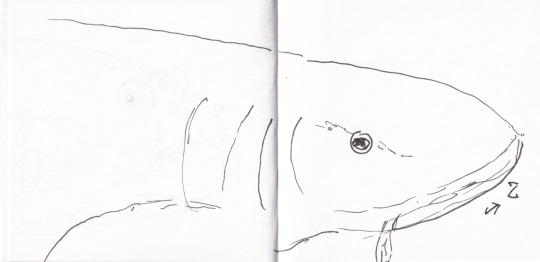
Some 10-15 minute plein air(?) Sketches of various creachurs at the Oklahoma Aquarium in Jenks.
In order of appearance:
Pacific Sea Nettle
White-Spotted Jelly
Clownfish & Sea Anemone
Horseshoe Crabs
Spiny Lobster
African Mudskipper
Some Shark I Didn't Get The Name Of (it was too dark in the tunnel to read the plaque)
#is it really plein air if there's three and a half inches of glass between you and the subject#sketch#sketchbook#art#artists on tumblr#Oklahoma Aquarium#Pacific Sea Nettle#white spotted jelly#clownfish#sea anemone#horseshoe crab#spiny lobster#African Mudskipper#shark
9 notes
·
View notes
Text
This is not a polar,a hot desert:The life of White Sand desert for @the6planet8ofbats

This a hot desert have white color,is not a polar is White Sand Desert this ecosystem has in Southern Gavet,this is a Burrower bat (Family:Fossoripteronyctidae) a Family of Dust bats become burrowers with wings!! This species Yellow Burrower (Fossoripteronyctus aureus) a top predator of this desert.

Why does the Desert have white Sand? İt's because of a Moss White Terror (Albobyron destructor) this are appeared in Middle batocene,some mosses has become carnivory has become named Carnivorous mosses,this species and others like it are also Plant parasites. But White Terror they were really profilitic and their lifespan was between 6 or 8 mouths!! İndivuals of this species began decimating Forests two year after of emergence. Then this forest disappearence and 30 Years later this Plant parasite carnivorous Moss become extinct,due to the emergence of Moss eating Bats (Folivoropteropodidae) a New family of herbivorous Flying Fox Descendants and the Previously infested forest was now left a hot desert where the survivors of this chaos thrive.

İn Late Batocene, New biomes has appeared. But White Terrors are not only Plant of white Sand desert,a shrub-like Cacshrub (Arbosculocactus sociala) has emergence this interesting cactae has chosen live in Large colonies,the minimum of which 3 or 15 while the maximum are 101,which makes it an eusocial flowering Plant. But plants are Burrower bats are not only organisms of this desert,platyhelminth White Sand hammerhead (Bipalium albopsammiensis) is a descendant of a Surviving hammerhead worms of this chaos. A fish Cactus-skipper (Periopthalmus terrestris cactobranchus) is a descendant of Atlantis Mudskippers (P.barbarus) adapted in deserts.
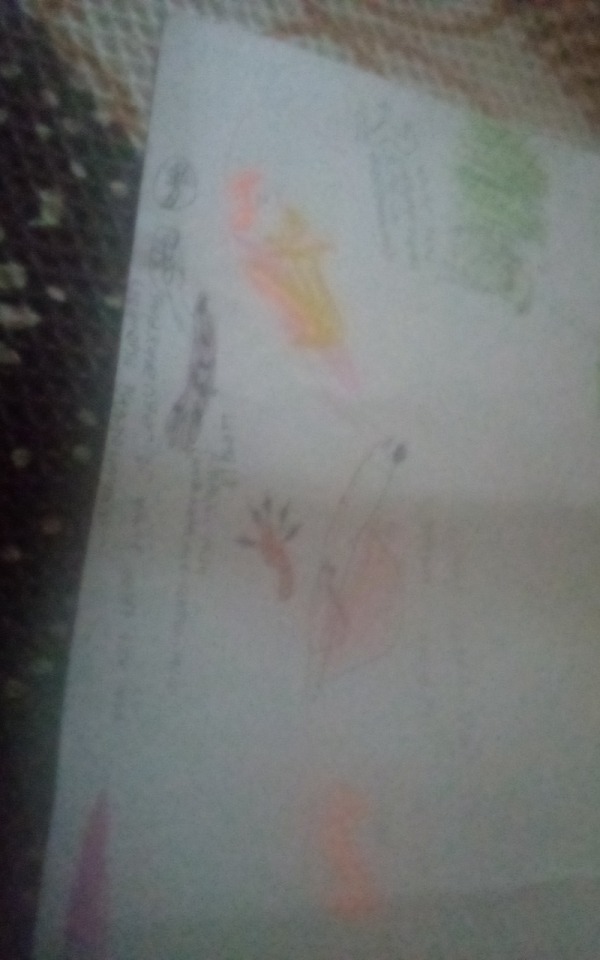
Other species like Oreworm (Lumbricus crystalia) a earthworm (Lumbricus terrestris) descendant it is extremely brigthly colored and the largest specimens of Oreworms are have 4 colors,but Oreworms have White Desert Fire Ant (Solenopsis psammoterrabilis) other name is Sandscavenger a fire ant (solenopsis spp.) Species has aggressive,females have stings and really hartful and venomous,males not have stings and a group of this ants killed amphibic squib (Amphibioteuthis cosmopoliticus) a squib across the shallow waters and coasts of this planet,it lives on land for 9 days and then moves water,like a swampus (future is Wild) and final species of this post is Giant Desert Snail (Xerogiga xerogiga) a land snail species has larger than Giant african Snail (Lissachatina fusca) this largest terrestrial mollusk of Earth,its herbivore eat Cacshrubs.
#the planet of bats#speculative evolution#seed world#speculative evolution seed world#speculative evolution seeded world#speculative zoology#future is wild#swampus
7 notes
·
View notes
Note
What is your favorite animal
serow, okapi, mudskipper, sea dragon, pink necked green pigeon, white's tree frog, striped pajama squid, African wild dog, panther chameleon, anteater, Caribbean reef octopus
0 notes
Text
Sometimes I am asked which fish they might purchase, along with the mudskippers, that has a true affinity for life on land, as opposed to simply possessing the ability to breathe air, or draw over the land. Top of the list must be two African catfishes of genus Gymnallabes and Chanallabes, known as the eel catfishes. (There are other species in these genera, but it is known, or assumed, that traded eel catfishes are of these two species.) These genera are related to the African and Asian walking catfishes, of the genus Clarias - but these leave the water only under environmental stress. Gymnallabes and Chanallabes are true fish, but they are habitually amphibious by their nature and prefetence. The entire clade Clariidae to which they belong, and its sister genus Heteropneustes, are bestowed gill arches modified into a novel respiratory organ, which is an evolutionary adaptation for breathing atmospheric air. Gas exchange also occurs through the skin of clariid catfishes.
Gymnallabes typus is native to West Africa, east to Cameroon, and is a relative of the Central African Chanallabes apus. These two catfish species are very similar, and G. typus is often incorrectly labelled in the trade as Chanallabes apus, which some people mistakenly think is the only species of eel catfish. One difference between the two species and their genera, is that Chanallabes catfish have lost their pectoral fins, and Gymnallabes have retained them. Of the two species, G. typus reaches only 30 centimetres or 12 inches long, and the larger C. apus can grow 7 centimeters or nearly 3 inches longer than this. Their body shape is strikingly eel-like, a similarity of form and function that formed the basis for the common name broadly applied to all such catfishes in English.
Eel catfishes routinely leave the water to forage amid damp leaf litter, in addition to frequenting forest streams, ditches, and swamps. Because these catfishes regularly seize insect prey when they foray on land, their ability to exploit terrestrial prey resources, has fascinated scientists interested in how our own Palaeozoic ancestors, quite independently of any true fish, became land animals. Needless to say, the aquaterrarium for these remarkable species should contain plenty leaves, such as Indian almond. Eel catfishes have evolved to burrow and hide among the leaf litter of humid African forests, both in and out of the water, and they will readily take advantage of aquarium decorations, as a place to shelter from bright light and stressful encounters. The land portion they are provided, must obviously remain damp.
Ideally the water pH should reflect the habitats of wild eel catfish. The rivers and streams of West Africa are more soft and acidic, with a typical pH value of 6 to 7, than are those of Central Africa, which hover around a value of 7. Although it is doubtful that the difference between these values, which are generalizations based on their geographical origins, would have any effect on the health of either species. Precaution must be taken that these slender and air breathing fishes, do not escape through holes in the lid. These burrowing, nocturnal animals have poor eyesight and are averse to bright light, so will be observed more often if the lighting is dim. Fortunately these catfish seem to do fine, when housed at normal, tropical aquarium temperatures. In the aquaterrarium they show disinterest in any animal that is not bothering them, and that they do not assume is potential prey.
Because these fish have small heads and gapes, only very small ornamentals could be at risk from these catfish. On principle, a wide range of mutually indifferent animals can thus share the land and water portions of the same aquaterrarium, without nasty accidents or incidents. One further consideration is that faster swimmers and boisterous feeders, might outcompete these benthic catfish, for the food that is provided to the whole aquarium community. Because eel catfish are essentially insectivores, their feeding is unprobematic. Food might be supplied for them in a frozen form, or as sinking tablets composed of appropriate ingredients. Although eel catfish have reportedly acclimatised in the aquarium to bolder, diurnal feedings, they might not cooperate, especially if they are recently imported from Africa.
0 notes
Text
Tidepools and Coastline
Coastline includes a variety of habitats, from tidepools to mangrove forests. They are a transitional space that many creatures are specialized to thrive in. If this is your home you probably take pride in what makes you unique. You know the world is dangerous but you choose not to let fear get the better of you. Coastal Animals: Plovers, Crabs, African penguin, Sculpin, California Sea Lion, Pelicans, Harbor Seal, Puffin, Spiny Dogfish, Mudskippers, Manatees, Herons, Marine Iguana
what is your natural habitat?
temperate forest : forests throughout the world which are made up of mostly deciduous trees, & go through the full range of seasons. if this is your home you are likely quick to adapt & hardworking. animals in the temperate forest: deer, squirrels, red panda, black bear, foxes, badgers, hedgehogs, raccoon, owls, sparrows.
⠂⠄⠄⠂⠁⠁⠂⠄⠄⠂⠁⠁⠂⠄⠄⠂⠁⠁⠂⠄⠄⠂⠂⠄⠄⠂⠁⠁⠂⠄⠄
quiz by ✶ whirligiga
48 notes
·
View notes
Text
Watch "You Won't Believe What These Africans Are "Fishing" Out of The Dirt 😱 #shorts #mudskippers" on YouTube
0 notes
Text

African Mudskipper
Periophthalmus barbarus
Source: Here
65 notes
·
View notes
Photo
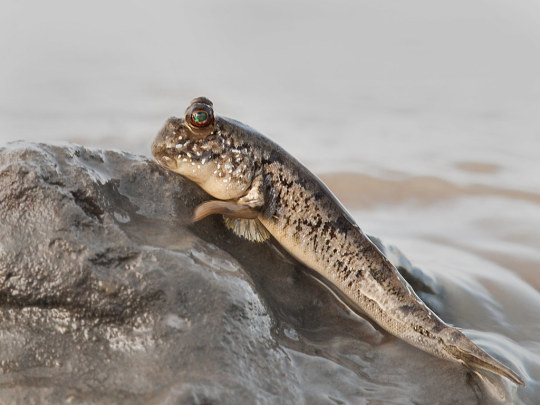

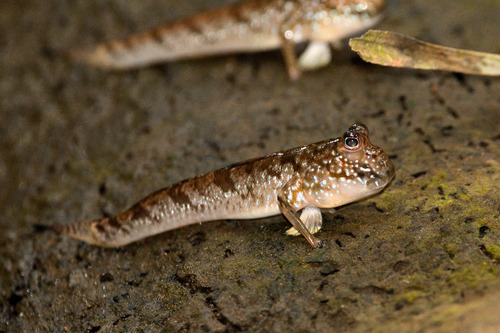
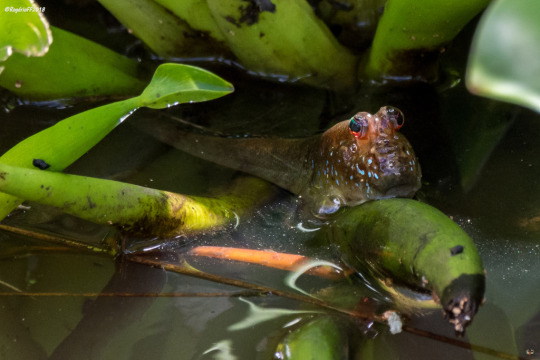
The Atlantic Mudskipper: A Fish Out of Water
Found only along the west African Cost, the Atlantic Mudskipper (Periophthalmus barbarus) is an incredibly unique species of fish. What makes it so special is that, unlike most other fish, the mudskipper can survive on land. It has several adaptations to make it semi-terrestrial. A layer of mucus over the surface of the body allows it to retain moisture, and when on land it can close its gill chambers and breathe through its skin. The eyes are set high on the head and can move independently 360 degrees, giving the Atlantic mudskipper a wide range of vision. Lastly, the pectoral fins that allow it to crawl, climb, and even skip on land, aided by a pair of pelvic fins.
P. Barbarus’ special adaptations allow it to occupy uncommon habitats within its range. It prefers semi-salty brackish water, especially at the mouths of rivers and in mudflats, although they are able to tolerate a range of temperatures and salinity. They can also be found in mangrove forests and lagoons, where they can climb up onto the roots of trees. Along the coast, individuals are most often visible at low tide when they climb up on the shore to feed. In these regions the Atlantic mudskipper digs burrows in which they can hide during high tide. To blend in, they are usually tan to dark brown with dark mottling along the back and bright blue spots on the cheeks.
During the day, the Atlantic mudskipper spends most of its time feeding and defending its territory. They are carnivorous fish, preying on crustaceans, insects, and small fish. The mouth of P. barbarbus is specially shaped so that it covers its prey with water, then sucks the water back up with its accompanying meal. When threatened by terrestrial predators such as shore birds, the Atlantic mudskipper lives up to its name and will ‘skip’ away. These fish also use their mouths in fights, which are quite common. Individuals typically guard of about 1m around their burrow. Males are especially territorial, and will fiercely guard burrows and mates from competitors. Despite their ferocity, Atlantic mudskippers are not very large; most only grow to be 14-16cm long.
Mating occurs year round, although peak times are between February and May. Males engage in territorial displays, after which females will select a male and enter his burrow to lay eggs. Clutches can easily number in the thousands, although few survive to adulthood. The male guards the burrow and, after a brief incubation period, floods it to induce hatching. Larvae drift for 1-2 months before metamorphosing into a juvenile stage, at which time they begin to return to land. Individuals reach sexual maturity at about 10.2-10.8 cm in length, roughly 1 year after hatching, and can live up to 5 years in the wild.
Conservation status: The IUCN rates the Atlantic mudskipper as Least Concern, although populations are declining. Their primary threats are from over-fishing and by-catch, pollution, and urban development. Some areas within their region have instituted sustainable fishing practices and established protected reserves as part of conservation efforts for this species.
Photos
Eva Mártensson
Eric Verhagen
Pedro Martins (via iNaturalist)
Rogerio Ferriera
#atlantic mudskipper#Gobiiformes#Oxudercidae#mudskippers#gobies#fish#Ray-Finned Fish#bony fish#wetlands#wetland fish#rivers#river fish#intertidal fauna#intertidal fish#coral reefs#coral reef fish#atlantic ocean#africa#west africa#animal facts#biology#zoology
150 notes
·
View notes
Text
I didn't know you could buy an African lungfish or mudskippers as a pet. Like my nearest pet store sells them and it blew my mind
4 notes
·
View notes
Photo

The full book title contains 3777 words and reads as follows: 'The historical development of the Heart i.e. from its formation from Annelida: Clam worm, Seamouse, Lugworm, Megascolex, Tubifex, Pheretima, Freshwater leech, marine leech, land leech. Arthropoda: Ladybird, Krill, Rock Barnacle, Root-headed Barnacle, Copepod, Silverfish, Cairns birdwing, Silver - spotted skipper, Scutigera, Cray fish, Large white, Andonis blue, Camberwell beauty, Tiger swallowtail, Regent skipper, Black – veined white, Green – underside blue, Blue Morpho, Apollo, Guava skipper, Cleopatra, Large copper, Millipede, Orb spider, Black widow spider, Giant crab spider, Wolf spider, Bird – eating spider, Tenebrionid beetle, Green Tiger beetle, African goliath beetle, Scolopendra, Diving beetle, African ground beetle, New guinea weevil, Barnacle, Lobster, Shrimp, Woodlice, Mite, Prawn, Housefly, Butterfly, Monarch butterfly, Peacock butterfly, Honey bee, Fairy shrimp, Horsehoe crab, Tick, Bluebootle, Froghopper, Yellow crazy ant, Water flea, Sea spider, Fiddler crab, Shiny spider crab, Hermit crab, Sail swallowtail, Red admiral, Morpho butterfly, Desert locust, Stephens island weta, Speckled bush cricket, Mole cricket, Dung – beetle, Euthalia ynipardus, Small blues, Termite, Hornet, Mosquito, Garden spider, Tarantula, Desert hairy scorpion, Emperor dragon – fly, Moth, Centipede, Wood ant, Stag beetle, Indian red admiral, Blue admiral, Harvestman, Hoverfly, Shield bug, Assassin bug, Cicada, Coreid bug, Rose aphid, Water – boatman, Wasp, June bug, Large tortoiseshell, Frog beetle, Mexican red – legged tarantula, Paintedlady, Sydney funnelweb spider, Small tortoiseshell, Mountain bumble bee, Trapdoor spider, Jumping spider, Daddy longlegs spider, Orchind bee, Asian carpenter bee, Parasitic bee, House spider, Giant longhorn beetle, Flea, Bedbug Beetle, Cockroach, Scorpion, Spider, Ant, Gnats, Grasshopper, Silver fish, Crab, Great green bush cricket, Elephant hawk – moth. Mollusca: Neomenia, Chaetoderma, Chiton, Lepidopleurus, Apple snail, Sea hare, Sea lemon, Dentalium, Freshwater mussel, Marine mussel, Pearl oyster, Cuttlefish, Giant squid, Chambered fish, Devilfish. Fishes or Pisces: African glass catfish, African lungfish, Aholehole, Airbreathing catfish, Alaska blackfish, Albacore, Alewife, Alfonsino, Algae eater, Alligatorfish, Alligator gar, Amberjack - Seriola dumerili, American sole, Amur pike, Anchovy, Anemonefish, Angelfish, Angler, Angler catfish, Anglerfish, Antarctic cod, Antarctic icefish, Antenna codlet, Arapaima, Archerfish, Arctic char, Armored gurnard, Armored searobin, Armorhead, Armorhead catfish, Armoured catfish, Arowana, Arrowtooth eel, Asian carps, Asiatic glassfish, Atka mackerel, Atlantic Bonito (Sarda sarda), Atlantic cod, Atlantic herring, Atlantic salmon, Atlantic Sharpnose Shark - Rhizoprioltodon terraenovae, Atlantic saury, Atlantic silverside, Australasian salmon, Australian grayling, Australian herring, Australian lungfish, Australian prowfish, Ayu, Baikal oilfish, Bala shark, Ballan wrasse, Bamboo shark, Banded killifish, Bandfish, Banjo, Bangus, Banjo catfish, Bank Sea Bass, Barb, Barbel, Barbeled dragonfish, Barbeled houndshark, Barbel-less catfish, Barfish, Barracuda, Barracudina, Barramundi, Barred danio, Barreleye, Basking shark, Bass, Basslet, Batfish, Bat ray, Beachsalmon, Beaked salmon, Beaked sandfish, Beardfish, Beluga sturgeon, Bengal danio, Betta, Bichir, Bicolor goat fish, Bigeye, , Bighead carp, Bigmouth buffalo, Bigscale, Billfish, Bitterling, Black angelfish, Black bass, Black dragonfish, Blackchin, Blackfin Tuna - Thunnus atlanticus, Blackfish, Black neon tetra, Blacktip reef shark, Black mackerel, Black scalyfin, Black sea bass, Black scabbardfish, Black swallower, Black tetra, Black triggerfish, Bank Sea Bass aka Yellow Sea Bass - Centropristis ocyurus, Bleak, Blenny, Blind goby, Blind shark, Blobfish, Blueline Tilefish, Blowfish, Blue catfish, Blue danio, Blue-redstripe danio, Blueline Tilefish , Blue eye, Bluefin tuna, Bluefish, Bluegill, Blue gourami, Blue shark, Blue triggerfish, Blue whiting, Bluntnose knifefish, Bluntnose minnow, Boafish, Boarfish, Bobtail snipe eel, Bocaccio, Boga, Bombay duck, Bonefish, Bonito, Bonnetmouth, Bonytail chub, Bronze corydoras, Bonytongue, Bowfin, Boxfish, Bramble shark, Bream, Brill, Bristlemouth, Bristlenose catfish, Broadband dogfish, Brook lamprey, Brook trout, Brotula, Brown trout, Buffalo fish, Bullhead, Bullhead shark, Bull shark, Bull trout, Burbot, Bumblebee goby, Buri, Burma danio, Burrowing goby, Butterfish, Butterfly ray, Butterflyfish, California flyingfish, California halibut, Canary rockfish, Candiru, Candlefish, Capelin, Cardinalfish, Cardinal tetra, Carp, Carpetshark, Carpsucker, Catalufa, Catfish, Catla, Cat shark, Cavefish, Celebes rainbowfish, Central mudminnow, Chain pickerel, Channel bass, Channel catfish, Char, Cherry salmon, Chimaera, Chinook salmon, Cherubfish, Chub, Chubsucker, Chum salmon, Cichlid, Cisco, Climbing catfish, Climbing gourami, Climbing perch, Clingfish, Clownfish, Clown loach, Clown triggerfish, Cobbler, Cobia, Cod, Codlet, Codling, Coelacanth, Coffinfish, Coho salmon, Coley, Collared carpetshark, Collared dogfish, Colorado squawfish, Combfish, Combtail gourami, Common carp, Common tunny, Conger eel, Convict blenny, Convict cichlid, Cookie-cutter shark, Coolie loach, Cornetfish, Cowfish, Cownose ray, Cow shark, Crappie, Creek chub, Crestfish, Crevice kelpfish, Croaker, Crocodile icefish, Crocodile shark, Crucian carp, Cuckoo wrasse, Cusk, Cusk-eel, Cutlassfish, Cutthroat eel, Cutthroat trout, Dab, Dace, Desert pupfish, Devario, Devil ray, Dhufish, Discus, Diver: New Zealand sand diver or long-finned sand diver, Dogfish, Dogfish shark, Dogteeth tetra, Dojo loach, Dolly Varden trout, Dolphin fish - Corypaena hippurus, Dorab, Dorado, Dory, Dottyback, Dragonet, Dragonfish, Dragon goby, Driftfish, Driftwood catfish, Drum, Duckbill, Duckbill eel, Dusky grouper, Dusky Shark - Carcharhinus obscurus, Dwarf gourami, Dwarf loach, Eagle ray, Earthworm eel, Eel, Eel cod, Eel-goby, Eelpout, Eeltail catfish, Elasmobranch, Electric catfish, Electric eel, Electric knifefish, Electric ray, Elephant fish, Elephantnose fish, Elver, Ember parrotfish, Emerald catfish, Emperor angelfish, Emperor bream, Escolar, Eucla cod, Eulachon, European chub, European eel, European flounder, European minnow, European perch, False brotula, False cat shark, False moray, Fangtooth, Fathead sculpin, Featherback, Fierasfer, Fire goby, Filefish, Finback cat shark, Fingerfish, Firefish, Flabby whale fish, Flagblenny, Flagfin, Flagfish, Flagtail, Flashlight fish, Flatfish, Flathead, Flathead catfish, Flier, Flounder, Flying gurnard, Flying fish, Footballfish, Forehead brooder, Four-eyed fish, French angelfish, Freshwater eel, Freshwater hatchetfish, Freshwater shark, Frigate mackerel, Frilled shark, Frogfish, Frogmouth catfish, Fusilier fish, Galjoen fis, Ganges shark, Geel, Garibaldi, Garpike, Ghost fish, Ghost flathead, Ghost knifefish, Ghost pipefish, Ghost shark, Ghoul, Giant danio, Giant gourami, Giant sea bass, Gibberfish, Gila trout, Gizzard shad, Glass catfish, Glassfish, Glass knifefish, Glowlight danio, Goatfish, Goblin shark, Goby, Golden dojo, Golden loach, Golden shiner, Golden trout, Goldeye, Goldfish, Gombessa, Goosefish, Gopher rockfish, Gourami, Grass carp, Graveldiver, Grayling, Gray mullet, Gray reef shark, Great white shark, Green swordtail, Greeneye, Greenling, Grenadier, Green spotted puffer, Ground shark, Grouper, Grunion, Grunt, Grunter, Grunt sculpin, Gudgeon, Guitarfish, Gulf menhaden, Gulper eel, Gulper, Gunnel, Guppy, Gurnard, Haddock, Hagfish, Hairtail, Hake, Halfbeak, Halfmoon, Halibut, Halosaur, Hamlet, Hammerhead shark, Hammerjaw, Handfish, Hardhead catfish, Harelip sucker, Hatchetfish, Hawkfish, Herring, Herring smelt, Hickory Shad, Horn shark, Horsefish, Houndshark, Huchen, Humuhumunukunukuapua'a, Hussar, Icefish, Ide, Ilisha, Inanga, Inconnu, Jack, Jackfish, Jack Dempsey, Japanese eel, Javelin, Jawfish, Jellynose fish, Jewelfish, Jewel tetra, Jewfish, John Dory, Kafue pike, Kahawai, Kaluga, Kanyu, Kelp perch, Kelpfish, Killifish, King of the herrings, Kingfish, King-of-the-salmon, Kissing gourami, Knifefish, Knifejaw, Koi, Kokanee, Kokopu, Kuhli loach, Labyrinth fish, Ladyfish, Lake chub, Lake trout, Lake whitefish, Lampfish, Lamprey, Lanternfish, Largemouth bass, Leaffish, Lefteye flounder, Lemon shark, Lemon sole, Lemon tetra, Lenok, Leopard danio, Lightfish, Limia, Lined sole, Ling, Ling cod, Lionfish, Livebearer, Lizardfish, Loach, Loach catfish, Loach goby, Loach minnow, Longfin, Longfin dragonfish, Longfin escolar, Longfin smelt, Long-finned char, Long-finned pike, Longjaw mudsucker, Longneck eel, Longnose chimaera, Longnose dace, Longnose lancetfish, Longnose sucker, Longnose whiptail catfish, Long-whiskered catfish, Loosejaw, Lost River sucker, Louvar, Loweye catfish, Luderick, Luminous hake, Lumpsucker, Lungfish, Mackerel, Mackerel shark, Madtom, Mahi-mahi, Mahseer, Mail-cheeked fish, Mako shark, Mandarinfish, Masu salmon, Medaka, Medusafish, Megamouth shark, Menhaden, Merluccid hake, Mexican golden trout, Midshipman fish, Milkfish,, Minnow, Minnow of the deep, Modoc sucker, Mojarra, Mola, Monkeyface prickleback, Monkfish, Mooneye, Moonfish, Moorish idol, Mora, Moray eel, Morid cod, Morwong, Moses sole, Mosquitofish, Mouthbrooder, Mozambique tilapia, Mrigal, Mud catfish (Mud cat), Mudfish, Mudminnow, Mud minnow, Mudskipper, Mudsucker, Mullet, Mummichog, Murray cod, Muskellunge, Mustache triggerfish, Mustard eel, Naked-back knifefish, Nase, Needlefish, Neon tetra, New World rivuline, New Zealand smelt, Nibble fish, Noodlefish, North American darter, North American freshwater catfish, North Pacific daggertooth, Northern anchovy, Northern clingfish, Northern lampfish, Northern pike, Northern sea robin, Northern squawfish, Northern stargazer, Notothen, Nurseryfish, Nurse shark, Oarfish, Ocean perch, Ocean sunfish, Oceanic whitetip shark, Oilfish, Oldwife, Old World knifefish, Olive flounder, Opah, Opaleye, Orange roughy, Orangespine unicorn fish, Orangestriped triggerfish, Orbicular batfish, Orbicular velvetfish, Oregon chub, Orfe, Oriental loach, Oscar, Owens pupfish, Pacific albacore, Pacific cod, Pacific hake, Pacific herring, Pacific lamprey, Pacific salmo, Pacific saury, Pacific trout, Pacific viperfish, Paddlefish, Pancake batfish, Panga, Paradise fish, Parasitic catfish, Parore, Parrotfish, Peacock flounder, Peamouth, Pearleye, Pearlfish, Pearl danio, Pearl perch, Pelagic cod, Pelican eel, Pelican gulper, Pencil catfish, Pencilfish, Pencilsmelt, Peppered corydoras, Perch, Peters' elephantnose fish, Pickerel, Pigfish, Pike conger, Pike eel, Pike, Pikeblenny, Pikeperch, Pilchard, Pilot fish, Pineapplefish, Pineconefish, Pink salmon, Píntano, Pipefish, Piranha, Pirarucu, Pirate perch, Plaice, Platy, Platyfish, Pleco, Plownose chimaera, Poacher, Pollock, Pomfret, Pompano dolphinfish, Ponyfish, Popeye catalufa, Porbeagle shark, Porcupinefish, Porgy, Port Jackson shark, Powen, Prickleback, Pricklefish, Prickly shark, Prowfish, Pufferfish, Pumpkinseed, Pupfish, Pygmy sunfish, Queen danio, Queen parrotfish, Queen triggerfish, Quillback, Quillfish, Rabbitfish, Raccoon butterfly fish, Ragfish, Rainbow trout, Rainbowfish, Rasbora, Ratfish, Rattail, Ray, Razorback sucker, Razorfish, Red Grouper, Red salmon, Red snapper, Redfin perch, Redfish, Redhorse sucker, Redlip blenny, Redmouth whalefish, Redtooth triggerfish, Red velvetfish, Red whalefish, Reedfish, Reef triggerfish, Remora, Requiem shark, Ribbon eel, Ribbon sawtail fish, Ribbonfish, Rice eel, Ricefish, Ridgehead, Riffle dace, Righteye flounder, Rio Grande perch, River loach, River shark, River stingray, Rivuline, Roach, Roanoke bass, Rock bass, Rock beauty, Rock cod, Rocket danio, Rockfish, Rockling, Rockweed gunnel, Rohu, Ronquil, Roosterfish, Ropefish, Rough scad, Rough sculpin, Roughy, Roundhead, Round herring, Round stingray, Round whitefish, Rudd, Rudderfish, Ruffe, Russian sturgeon, Sábalo, Sabertooth, Saber-toothed blenny, Sabertooth fish, Sablefish, Sacramento blackfish, Sacramento splittail, Sailfin silverside, Sailfish, Salamanderfish, Salmon, Salmon shark, Sandbar shark, Sandburrower, Sand dab, Sand diver, Sand eel, Sandfish, Sand goby, Sand knifefish, Sand lance, Sandperch, Sandroller, Sand stargazer, Sand tiger, Sand tilefish, Sandbar Shark - Carchathinus plumbeus, Sarcastic fringehead, Sardine, Sargassum fish, Sauger, Saury, Sawfishm, Saw shark, Sawtooth eel, Scabbard fish, Scaly dragonfish, Scat, Scissortail rasbora, Scorpionfish, Sculpin, Scup, Sea bass, Sea bream, Sea catfish, Sea chub, Sea devil, Sea dragon, Sea lamprey, Sea raven, Sea snail, Sea toad, Seahorse, Seamoth, Searobin, Sevan trout, Sergeant major, Shad, Shark, Sharksucker, Sharpnose puffer, Sheatfish, Sheepshead, Sheepshead minnow, Shiner, Shortnose chimaera, Shortnose sucker, Shovelnose sturgeon, Shrimpfish, Siamese fighting fish, Sillago, Silver carp, Silver dollar, Silver dory, Silver hake, Silverside, Silvertip tetra, Sind danio, Sixgill ray, Sixgill shark, Skate, Skilfish, Skipjack tuna, Slender mola, Slender snipe eel, Sleeper, Sleeper shark, Slickhead, Slimehead, Slimy mackerel, Slimy sculpin, Slipmouth, Smalleye squaretail, Smalltooth sawfish, Smelt, Smelt-whiting, Smooth dogfish, Snailfish, Snake eel, Snakehead, Snake mackerel, Snapper, Snipe eel, Snipefish, Snoek, Snook, Snubnose eel, Snubnose parasitic eel, Sockeye salmon, Soldierfish, Sole, South American darter, South American lungfish, Southern Dolly Varden, Southern flounder, Southern hake, Southern sandfish, Southern smelt, Spadefish, Spaghetti eel, Spanish mackerel, Spearfish, Speckled trout, Spiderfish, Spikefish, Spinefoot, Spiny basslet, Spiny dogfish, Spiny dwarf catfish, Spiny eel, Spinyfin, Splitfin, Spookfish, Spotted climbing perch, Spotted danio, Spottail Pinfish - Diplodus holbrooki, Sprat, Springfish, Squarehead catfish, Squaretail, Squawfish, Squeaker, Squirrelfish, Staghorn sculpin, Stargazer, Starry flounder, Steelhead, Stickleback, Stingfish, Stingray, Stonecat, Stonefish, Stoneroller minnow, Stream catfish, Striped bass, Striped burrfish, Sturgeon, Sucker, Suckermouth armored catfish, Summer flounder, Sundaland noodlefish,Sunfish, Surf sardine, Surfperch, Surgeonfish, Swallower, Swamp-eel, Swampfish, Sweeper, Swordfish, Swordtail, Tadpole cod, Tadpole fish, Tailor, Taimen, Tang, Tapetail, Tarpon, Tarwhine, Telescopefish, Temperate bass, Temperate perch, Tenpounder, Tenuis, Tetra, Thorny catfish, Thornfish, Threadfin, Threadfin bream, Thread-tail, Three spot gourami, Threespine stickleback, Three-toothed puffer, Thresher shark, Tidewater goby, Tiger barb, Tigerperch, Tiger shark, Tiger shovelnose catfish, Tilapia, Tilefish, Titan triggerfish, Toadfish, Tommy ruff, Tompot blenny, Tonguefish, Tope, Topminnow, Torpedo, Torrent catfish, Torrent fish, Trahira, Treefish, Trevally, Triggerfish, Triplefin blenny, Triplespine, Tripletail, Tripod fish, Trout, Trout cod, Trout-perch, Trumpeter, Trumpetfish, Trunkfish, Tubeblenny, Tube-eye, Tube-snout, Tubeshoulder, Tui chub, Tuna, Turbot, Two spotted goby, Uaru, Unicorn fish, Upside-down catfish, Vanjaram, Velvet belly lanternshark, Velvet catfish, Velvetfish, Vermillion Snapper - Rhomboplites aurorubens, Vimba, Viperfish, Wahoo, Walking catfish, Wallago, Walleye, Walleye Pollock, Walu, Warmouth, Warty angler, Waryfish, Waspfish, Weasel shark, Weatherfish, Weever, Weeverfish, Wels catfish, Whale catfish, Whalefish, Whale shark, Whiff, Whitebait, White croaker, Whitefish, White marlin, White shark, Whitetip reef shark, Whiting, Wobbegong, Wolf-eel, Wolffish, Wolf-herring, Worm eel, Wormfish, Wrasse, Wrymouth, X-ray fish, Yellowback fusilier, Yellowbanded perch, Yellow bass, Yellowedge grouper (Hyporthodus flavolimbatus), Yellow-edged moray, Yellow-eye mullet, Yellowhead jawfish, Yellowfin croaker, Yellowfin cutthroat trout, Yellowfin grouper, Yellowfin Tuna - Thunnus albacares, Yellowfin pike, Yellowfin surgeonfish, Yellowfin tuna, Yellowmargin triggerfish, Yellow moray, Yellow perch, Yellowtail, Yellowtail amberjack, Yellowtail barracuda, Yellowtail clownfish, Yellowtail horse mackerel, Yellowtail kingfish, Yellowtail snapper, Yellow tang, Yellow weaver, Yellowtail catfish, Zander, Zebra bullhead shark, Zebra danio, Zebrafish, Zebra lionfish, Zebra loach, Zebra oto, Zebra pleco, Zebra shark, Zebra tilapia, Zebra turkeyfish, Ziege, Zingel. Amphibians: Frogs and Toads, Painted frogs, Disc tongued frogs, Fire Belly toads, Litter frogs, European Spadefoot toads, Parsley frogs, Tongueless frogs, Clawed frogs, Mexican Burrowing Toad, American spadefoot toads, Screeching frogs, True toads, Glass Frogs, Poison dart frogs, Ghost frogs, Shovelnose frogs, Tree frogs, Sedge frogs, Southern frogs, Narrow-mouthed frogs, Australian ground frogs, True frogs, Moss frogs, Seychelles frog, Giant Salamanders, Asiatic Salamanders, Mole Salamanders, Pacific giant salamanders, Amphiumas, Lungless salamanders, Mudpuppies and Waterdogs, Torrent salamanders, True salamanders and Newts, Sirens, Common caecilians, Fish caecilians, Beaked caecilians. Reptiles: Turtles, common snapping turtles and alligator snapping turtle, pond turtles and box turtles, tortoises, Asian river turtles and allies, pignose turtles, softshell turtles, river turtles, mud turtles, sea turtles, leatherback turtles, tuataras, scaled reptiles, agamas, chameleons, casquehead lizard, iguanas, Madagascar iguanids, collared and leopard lizards, horned lizards, anoles, wood lizards, Neotropical ground lizards, geckos, legless lizards, blind lizards, spinytail Lizards, plated lizards, spectacled lizards, whiptails and tegus, Lacertids, skinks, night lizards, glass lizards, American legless lizards, knob-scaled lizards, gila monsters, earless Monitor lizards, monitor lizards, worm Lizards, shorthead Worm Lizards, two-legged Worm Lizards, snakes, wart snakes, false coral snakes, dwarf pipe snakes, African burrowing asps, stiletto snakes, boas, anacondas, Old World sand boas, Mauritius snakes, Colubrids, typical snakes, Asian pipe snakes, cobras, coral snakes, mambas, sea snakes, Mexican pythons, pythons, dwarf boas, pipe snakes, shield-tailed snakes, vipers, pitvipers, Fae's viper, night adders, pitvipers, rattlesnakes, true vipers, sunbeam snakes, blind snakes, primitive blind snakes, slender blind snakes, thread snakes, blind snakes, typical blind snakes, Crocodiles, alligators, garials. Aves: Ostrich, rheas, cassowaries and emu, kiwis, elephant birds, upland moas, great moas, lesser moas, Tinamous, Australian brush turkey,megapodes, chachalacas, curassows, and guans, Guineafowl, pheasants and allies, New World quail, pheasants and relatives, mihirungs, screamers, magpie-goose, ducks, geese, and swans, grebes, swimming flamingos, flamingos, pigeons and doves, sandgrouse, mesites, Tawny frogmouth, Nightjars, oilbird, potoos, frogmouths, owlet-nightjars, treeswifts, swifts, hummingbird, cuckoos and relatives, turacos and relatives, bustards, hoatzin, cranes and allies, cranes, limpkin, trumpeters, rails and allies, adzebills, finfoots, flufftails, rails and relatives, thick-knees and allies, thick-knees and relatives, sheathbills, Magellanic plover, plover-like waders, golden plovers, ibisbill, oystercatchers, plovers and lapwings, jacana-like waders, painted snipes, Egyptian plover, jacanas, seedsnipes, plains-wanderer, sandpipers and relatives, buttonquail, gulls and allies, coursers and pratincoles, crab-plover, skuas and jaegers, auks and puffins, gulls, skimmers and terns, sunbittern, tropicbirds, penguins, albatrosses, austral storm petrels, northern storm petrels, petrels and relatives, White stork, storks, frigatebirds, boobies and gannets, darters, cormorants and shags, ibises and spoonbills, hamerkop, shoebill, pelicans, herons and relatives, New World vultures, secretarybird, osprey, hawks, eagles, buzzards, harriers, kites and Old World vultures, barn owls, true owls, mousebirds, cuckooroller, trogons and quetzals, hornbills, hoopoe, woodhoopoes, bee-eater, rollers, ground rollers, todies, motmots, Kingfisher, jacamars, puffbirds, African barbets, Asian barbets, toucans, toucan barbets, American barbets, woodpeckers, honeyguides, seriemas, falcons and relatives, kakapo, kea and kakas, cockatoos, African and American parrots, Australasian parrots, Pesquet's parrot, vasa parrots, Pitta cyanea, Lyrebird, New Zealand wrens, suboscines, Old World suboscines, sapayoa, Calyptomenid broadbills, pittas, broadbills, asities, New World suboscines, bronchophones, manakins, cotingas, sharpbills, royal flycatchers and allies, becards and tityras, spadebills, many-colored rush tyrants, mionectine flycatchers, tyrant flycatchers, tracheophones, crescent-chests, gnateaters, antbirds, antpittas, ground antbirds, ovenbirds, oscines, scrub-birds, lyrebirds, bowerbirds, Australasian treecreepers, Australasian wrens, bristlebirds, gerygones and allies, honeyeaters and relatives, Australasian babblers, logrunners, quail-thrushes and jewel-babblers, cuckoo-shrikes, whitehead and allies, sittellas, wattled ploughbills, whipbirds and quail-thrushes, Australo-Papuan bellbirds, crested shriketits, painted berrypeckers, vireos and relatives, whistlers and relatives, Old World orioles, Boatbills, woodswallows and butcherbirds, mottled berryhunter, ioras, bristlehead, bushshrikes and relatives, wattle-eyes and batises, vangas , fantails, silktail, drongo fantail, drongos, blue-capped ifrits, Australian mudnesters, birds-of-paradise, monarch flycatchers, shrikes, jays and crows, berrypeckers, satinbirds, Australasian robins, stitchbird, wattlebirds, rockfowl, rock-jumpers, rail-babbler, fairy warblers, hyliotas, penduline tits, chickadees and true tits, Nicators, bearded reedling, larks, African warblers, cisticolas and relatives, marsh warblers, pygmy wren-babblers, grass warblers, Malagasy warblers, swallows and martins, bulbuls, leaf warblers, bush warblers , Bushtits, true warblers, parrotbills, fulvettas, white-eyes, babblers and relatives, fulvettas, ground babblers, laughing thrushes, kinglets, spotted wren-babblers, Hawaiian honeyeaters, silky-flycatchers, waxwings, Palmchat, hypocolius, wallcreeper, nuthatches, treecreepers, wrens, gnatcatchers, dippers, thrushes and relatives, flycatchers and relatives, oxpeckers, mockingbirds and thrashers, starlings and mynas , sugarbirds, dapplethroat and allies, flowerpeckers, sunbirds, fairy-bluebirds, leafbirds, olive warbler, accentors, pink-tailed bunting, weavers and relatives, whydahs and indigobirds, weaver finches, Old World sparrows, wagtails and pipits, finches and relatives, longspurs, snow buntings, rosy thrush-tanagers, Old World buntings and New World sparrows, American sparrows, palm-tanager and allies, New World blackbirds and New World orioles, Cuban warblers, wood warblers, cardinals, grosbeaks, and New World buntings, tanagers and relatives. MAMMALS: Rat, Bat, Horse, Standardbred, Throughbred, Saddlebred, Arab, Palomino, Australian stock, Appaloosa, Barb, Lippizaner, Mustang, American Shetland, Falabella, Percheron, Shire, Mule, Bullock, Setter, Oxen, Camel, Tiger, Lion, Hyaenas, Leopard, Bear, Cat, Dog, Sheep, Goat, Cow, Cob, Pig, Chamois, Bulldog, Borzoi, Loris, Longspur, Harvest mouse, Spiny – ant eater, Duck – billed platypus, Elephant, Rhinoceros, Tonkinese, Ragdoll, Margay, Tapir, Seal, Sea lion, Walrus, Dolphin, Bactrian camel, Arabian camel, Bushbaby, Burmese cat, Whale, Porpoise, Aardvark, Ape, Monkey, Gorilla, Chimpanzee, Flying Lemur, Hare, Pika, Macaque, Rabbit, Colobus, Antelope, Caribou, Cattle, Deer, Grizzly bear, Hyrax, Armadillo, Porcupine, Hedgehog, Arctic hare, Mole, Shrew, Beaver, Asian black bear, Polar bear, Sloth bear, Spectacled bear, Mouse, Squirrel, Dugong, Moose, Fallow deer, Reindeer, Red deer, Manatee, Egyptian Mau, Scottish fold, Himalayan, Birman, Red squirrel, Hippopotamus, Weasel, Whale, Wither, Blue whale, Sperm whale, Killer whale, Wallaby, Beluga, Baird’s beaked whale, Grey whale, Bryde’s whale, Pygmy right whale, Southern right whale, Seal, Ape, Indri, Aye – aye, Alaskan Malamute, Dobermann, Beagle, Kinkajou, Afgan Hound, Rough Collie, Cardigan Welsh Corgi, Sheepdog, Pointer, Poddle, Weimaraner, Bloodhound, Zebra, Giraffe, Yak, Arctic fox, Polecat, Golden Retriever, Kerry Blue, Prairie dog, Airedale, German spitz, Pekingese, Otter, Shih Tzu, Proboscis monkey, Orang – utan, Red Howler monkey, Spider monkey, Sloth, Koala, Pangolin, Mustelid, Mongoose, Guinea pig, Malayan Porcupine, Naked Mole rat, Capybara, Pallid Gerbil, Brown rat, Somali, Ocicat, Balinese, Bengal, Cymric, Chartreux, Devon Rex, Turkish Angora, Russian Blue, Yellow – necked woodmouse, Hamster, Grey squirrel, Chipmunk, Fox, Blue Longhair, Chinese Pangolin, Blue – cream shorthair, Tortoiseshell and white shorthair, Brown spotted shorthair, Red and white Japanese bobtail, Javanese, Red Persian Longhair, Brown classic tabby maine coon, Lilac angora, Seal point Siamese, Brown and white sphinx, Red classic tabby manx, Vampire bat, Proboscis bat, Franquet’s fruit bat, Bengal Tiger, Horseshoe bat, Noctule bat, Funnel - eared bat, Blue exotic, Foreign lilac oriental shorthair, Boxer, Bay, Cream point colour pointed british shorthair, Abyssinian, Cinnamon silver Cornish rex, Wolverine, Skunk, Human being, Pine marten, Stoat, Chocolate point longhair, Husky, Ant eater, Kangaroo, Gray Mouse Lemur, Musk oxen, Raccoon dogrie, Pasnda, Bouto, Pembroke Welsh corgi, Whippet, Whisker, Indus river dolphin, Franciscana, Sorrel, Finless porpoise, Jerboa, Harbour porpoise, Bottlenose dolphin, Border Collie, Diana Monkey, White – beaked dolphin, Atlantic white – sided dolphin, Bobcat, Alpaca, Aberdeen angus, Lynx, Pacific white – sided dolphin, Rhesus monkey, Irish wolfhound, Baboon, Slivery marmoset, Puma, Ocelot, Norwegian Forest Cat, Basenji, Keeshond, Akita, Samoyed, Briard, Brittaney, Vizsla, Weimaraner, Saluki, Greyhound, Rottweiler, Bullmastiff, Newfoundland, Puli, Bombay, Sphynx, Kangaroo rat, Humpback whale, Red panda, Maltese, Pug, Chihuahua, Papillon, Pomeranian, Schipperke, Aardwolve, Cheetah, Civet, Red – Bellied Lemur, Moustache, Monkey, Yorkshire terrier, German shepherd, Clumber spaniel, Bouvier des Flandres, Belgian sheepdog, Boston terrier, Italian greyhound, Chesapeake Bay retriever, Genet, Musk deer, Bichon fries, Rock Hyrax, Pony, Mink, Mammoth, Mastodon, Giant sloth, Llama, African Elephant, DeBrazza’s Monkey, Siberian Tiger, Hackney Pony, Bonnet Monkey, German wirehaired pointer, Ferret, Jaguar, Dalmatian, Red Bengal Tiger, Badger, Shunk, Skye terrier, Great dane, Grampus, Bandicoot, Wolf, Marmot, Squirrel monkey, Sable, Minke whale, Spectacle porpoise, Opossums, Airedale, Wombat. etc , Ramapithecus, Australopithecus bosei or Paranthropus bosei, Zinjanthopus bosei, Homo – erectus ( Java man, Peking man, Heidelberg man ), Homo – Sapiens ( Neanderthal man, Cro – Magnon man) to the modern humans with their development and structure of their Heart, their contributions to the formation of the modern humans. What is the origin of the heart? In which place the heart is situated? What is the weight of our (modern humans) heart? Can a person live without a heart? What is the function of the heart? How heart pumps blood to the body? What type of circulation takes place in the human heart? How big our human heart is? Why is our (modern humans) heart considered as the most developed in the world? Why does heart stop? What are heart sounds? What are the types of heart sounds? What causes the heart sounds heard with a stethoscope? What is the anatomy of the heart? Why heart is considered an important organ in the body? Why can’t people live if heartbeat stops? Where is heart located in? How many chambers are present in the heart? What is the number of heart beats per minute? What is the amount of blood pumped by heart? How much blood does the human heart pump in a lifetime? And Short notes on heart attack i.e. what is the definition of a heart attack? Why does a heart attack occur? What are the types of the heart attack? What happens if human get a heart attack? What are the symptoms of Heart attack? What are the causes of the Heart attack? What are the risk factors related to the Heart attack? What are the types of risk factors cause the Heart attack? What are the complications of a Heart attack? What types of diagnosis useful in detecting and treating a heart attack? What treatment is needed to treat heart attack patients? What are 5 strategies to be maintained after the heart attack? What to do after recovery from a heart attack? What is cardiac rehabilitation? Why cardiac rehabilitation is needed to heart attack patients? Does cardiac rehabilitation create positive effects? What are a lifestyle and home remedies are to be maintained? What type of coping and support should be given to heart attack patients? What are the immediate measures should be taken when you encounter an emergency of heart attack patient? What signs and symptoms list should be made to consult a doctor? What is a widow maker heart attack? What is the definition of a widowmaker heart attack? What are the symptoms of Widowmaker heart attack? What are the causes of Widowmaker heart attack? What are the risk factors related to Widowmaker heart attack? What are the complications of a widowmaker heart attack? What types of diagnosis useful in detecting and treating a widowmaker heart attack? What treatment is needed to treat heart attack patients? How to make over your lifestyle? What type of measures should be taken to stay away from a heart attack? What are 20 types of foods should be taken to keep your heart healthy? Solutions and answers of above questions, material and topics are included and cleared in this book.'
26 notes
·
View notes
Text
Living Things Tags
African clawed frogs
African greys
alligators
alpacas
amphibians
animals
anteaters
arthropods
badgers
ball pythons
bats
bearded dragons
bears
beetles
belugas
birds
blue-tongued skinks
bugs
capybaras
cassowaries
catfish
cats
cephalopods
cetaceans
chameleons
cheetahs
chickens
cicadas
cobras
cockatiels
cockatoos
common snapping turtles
corvids
crabs
crayfish
crows
dinosaurs
dogs
dolphins
doves
ducks
Dunkleosteus
eels
electric eels
equids
European starlings
ferrets
finches
fish
flies
frogs
gars
geckos
geese
giraffes
Guinea pigs
hamsters
hedgehogs
hermit crabs
herons
hognoses
horses
hummingbirds
iguanas
insects
invertebrates
jellyfish
kangaroos
Komodo dragons
leopard geckos
leporids
lions
lizards
lobsters
macaws
mammals
marsupials
mice
molluscs
monitors
monkeys
moose
mosquitos
mourning doves
mudskippers
newts
octopuses
opossums
orcas
ostriches
otters
owls
parrots
pelicans
penguins
pigs
pigeons
pink iguanas
puffins
pythons
quails
rabbits
raccoons
rats
ravens
rays
reptiles
rodents
salamanders
scorpions
sea turtles
secretarybirds
Senegal parrots
sharks
sheep
skates
skinks
skunks
snakes
snapping turtles
spiders
squids
squirrels
starlings
swans
swine
tarantulas
tegus
toads
tortoises
toucans
tree frogs
turkeys
turtles
Uromastyx
wallabies
walruses
whales
wombats
woodpeckers
worms
zebras
[back]
0 notes
Text
Okay, here's mine
Animals
Yes it is simple but they are just so cool. I mean have you seen giant otters they have such awesome tummies. And then there is the Qinling Panda which is brown and very rare, they actually only live in one province of China. Oh and there is this creature called a mudskipper which is am amphibious fish so despite being fish they actually spend the majority of their time on land. Oh and have you heard of Hairy Frogs, they break their bones to create these tiny hairs that act as weapons and glass frogs are actually see through on their chest so you can see their organs. Oh and have you ever seen a red eyed tree frog, there isn't anything special about them, I just like 'em. Oh and poison dart frogs actually produce enough poison on their skin to kill a herd of elephant so don't touch one. Pugs fucking suck and are unnatural evidence of humanity going to fat, they can't even breathe, they aren't cute their crying out in pain. Another cool thing is vampire bats whose diet consists of BLOOD, mostly cow and small animal blood, but they are adorable. Oh and they cry of an African penguin sounds exactly like a donkey (sound linked here) so some people call them Jackass Penguins. Also Platypuses are not the only egg laying mammal, there are also Echindas who were not in fact created by sonic, but do lay eggs. Oh and slothes move so slow that moss grows on them. For my final bit of rambling on, if you go to a zoological institution you have to buy a stuff animal, those are the rules.
PS: planet zoo with mods is way to addicting
Anyways since you have gone through my stream of consciousness have some pictures of the animals discussed.
Giant Otter:

Qinling Panda:

Mudskipper:

Hairy frog:

Glass Frog:

Red Eyed tree frog:

Poison dart frog:

Vampire bats:

African penguin:

Echinda:

I hit tumblrs image limit so here is a link to a three toed sloth
PS2: who wants to hear about how I lost my phone at the Lincoln Park zoo
infodump chain ⬇️
tell me about your current hyperfixation or special interest or something that you just really like! i love to know random facts about random stuff so spill it
i’ll go first
okay so basically i’m really into quantum theory. if you don’t know it’s the theory that there are infinite amounts of other universes out there, some of which might even have different laws of physics. for example, there might be a universe out there quintillions of light years away where everything is the exact same except i have one less strand of hair on my head. if there are different laws of physics in some of them, then technically there might be a universe where people could levitate (which is SO sick). by this logic, because there are infinite amounts of universes, all of them different, there is a universe where it is in 2014 right now. if we somehow proved that quantum theory is true and figured out a way to safely travel between parallel universes, we could, theoretically, time travel. if you wanted to change anything, then you could only change any events in the universe where it is the past/future. nothing in our current universe would change, but you could change events in other universes. that’s how i think that time travel is eventually going to be invested (probably by elon musk ngl) but yeah. i also know how squids can evolve so fast because of their advanced rna systems but that’s a whole separate tangent. hope y’all have a great day! <3
10 notes
·
View notes
Video
instagram
#Repost @insecthaus_adi (@get_repost) ・・・ A lot people ask me about these animals 😂☝️ This are African Mudskipper, a fish that lives also on land.
4 notes
·
View notes
Photo
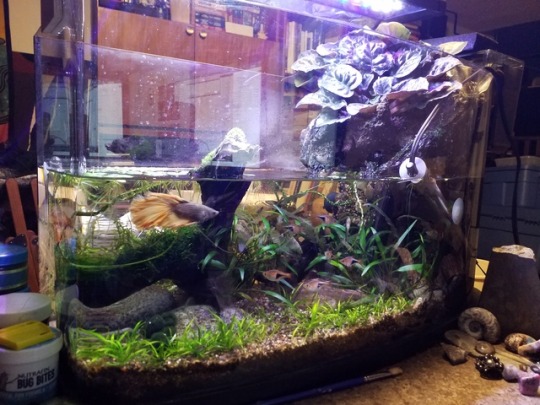
Just finished cleaning my fish tank, so thought i would share, because I think it’s been quite a while since I have shared an update on it. And also talk about plans for the future. For reference, this is what it looked like shortly after setting up (and still with lots of tannins in the water) http://rayegunn.tumblr.com/post/131499725421/paludarium-update-photos-with-cat-for-scale-its Everything is largely the same, layout wise, but some plants didn’t make it, (Pogostomon just didn’t get enough light) others have done very well. If you read that, you will notice that the tank inhabitants are not what I had planned. I ran into disease problems with the frogs, and gave up on them since there seemed to be an issue at the distributor level with Chytrid fungus, Shrimp just don’t seem to do well for me for some reason, and I realized the gobies would be ill advised since they are brackish. Extensive rambling below the cut.
For those unfamiliar with it, it is a paludarium with a self watering planter, and contains approximately 10 gallons of water. occupants are 1 Betta named Jesse, 6 Harlequin Rasboras, 5 Pygmy Cories, 2 Ottocinclus, 2 Assassin Snails (which I have no idea what they are eating because the pond snails were eradicated like a year ago. I think they eat the Cories sinking shrimp tablets, maybe) I built the terrestrial part out of a flower pot cut in half then the two halves glued together to create a tower, covered in expanding foam and silicone covered in dirt. The terrestrial part used to contain several types of plant, but the African Violet choked out everything else, it’s huge and doing very well. There is also some moss growing on the submerged wood, and along the edges of the pot/stream area. Aquatic plants are mostly assorted Crypts, but also some Anubias (on the back of the driftwood, can’t see it from this angle), Spiky Moss, (which was redone about a week ago because it had overtaken the left side of the tank, so it’s looking a bit scraggly there) Crinum calamistratum (but I have had troubles with the leaves wanting to stick out of the water, because it is shallow, and they then dry out and die, so there are only 4 leaves on it at the moment), Rotala rotundifoia, (recently trimmed so you can’t see much of it) and I added some Pygmy Chain Sword in the front there recently, it hasn’t entirely filled in yet, but it seems to be catching on. Oh and some moss balls, which I see now are piled up in a corner there to get them out of the way, but they’re normally kinda scattered here and there.
I created it as an experiment, because I want to do something similar on a larger scale, but wanted to work out the kinks small scale. And there are definitely some things I will be doing differently, after having this tank for over a year, i guess? As a concept, it definitely works, but as you can see i have had to stick a heater outside the internal compartment because i needed one larger than would fit inside the hidden area. Kinda spoils the aesthetic, to be sure (though the betta likes resting on it, so whatever. I’ve placed a barrier so he doesn’t burn his fins) I also find the fluctuating water level frustrating. Between evaporation and the planter drawing off water, the water level can go down fairly rapidly, and I have to keep it topped off with a pitcher of water every other day or so. I also had problems with water surface movement leading to biofilm, so had to add a bubbler, leading to the water spatter on the back glass.
All these problems I think can be solved by the larger version using a hidden sump for filtration, with the nylon ropes for the planter dangling into the overflow. It will increase water volume, will skim the surface to take care of the biofilm, and will keep the surface level of the water completely unchanging. the prospect of drilling a tank is a little daunting, but I’ve watched a lot of tutorials on how to do it and I’m feeling pretty confident about it. And I may be able to find one that’s pre-drilled anyway. Then, I would cover up the overflow with rocks and etc. and have the flower pot with a matching fitted base, and it would just pop in the top, so you could lift it out if necessary. You’d be able to see the small holes the water flows into around the edges if you looked close, but shouldn’t be too bad, especially if there is a bit of an overhang at the surface of the water to create a shadow. I’d also be able to hide the heater inside the sump, to keep everything nice and uncluttered. I would also likely use grout or something to cover the sump, rather than potting soil as that has proved to be less than durable. Luckily the front isn’t too bad, but the soil has worn off almost completley in the back, looks horrible. I cover it with an almond leaf.
Should work just fine. As for the tanks, I think I will definitely go BIG. I want 75 gallons+ preferably more in the 125 area, I’ll have to scan the classified around here when the time comes and see what I can come up with, so i can keep it more on the affordable side, and I want TWO of them. Only one of which will have a planter up top.
One will be freshwater, and I want to stock it with Pearl Gouramis, German Blue Rams, and a school of maybe Black Skirt Tetras, I’ve always liked those. Also Bronze Cories, can’t go wrong with Cories. but if i go large enough with the tank, I may switch those out for some Clown Loaches. And the stars would be a Small Scale Archer fish and/or a school of Marbled Hatchet Fish. If you are going for a paludarium, you may as well stock it with fish that can utelize the open air/dry land if at all possible. Archers have a unique hunting behaviour, where they shoot jets of water at insects above the water, something they can only really do in a paludarium type setup. And Hatchetfish are flying fish, able to glide through the air on their specialize pectoral fins, and are able to catch small insects midair. Yes, this means i will have to begin keeping crickets and blackflies, but it will be cool. I want this tank to be fairly heavily planted, but as i discovered with the small one, since the light has to sit so high above the water, you kind of have to stick to low light plants, even with a strong light fixture. but that’s fine, there are plenty of beautiful low light plants. I already have lots of crypts i can take from the smaller tank, as well as some Rotala and Pygmy Chain Sword, but I’d likely fill it in with some Anubias and Java Fern.
And that brings us to the second tank, probably the one i am most excited about. It would be a brackish tank (kinda part way between fresh and ocean water) and would contain Mudskippers (most likely Indian Dwarf skippers), Fiddler Crabs, and a Dragon Goby. I’d also likely add some middle water fish, likely either mollies (natural type colouration) or orange chromide cichlids. Mudskippers actually walk on their petcoral fins, so they and the fiddler crabs would be climbing out of the water, and I would create little sandy flats that the water spills down, and try and create a mangrove look for the tank. After doing some research and narrowing down my inhabitants, it’s looking like i will be looking at a Specific Gravity (salinity) of between 1.005 and 1.010, which should allow me to maintain certain aquatic plants, like Java Fern and Anubias, so it should still have a bit of green, but this one will be mostly hardscape, with lots of ermerged wood and rocks for the fiddlers and skippers to climb on.
Archers actually come in several varieties, one of which, and probably the most commonly seen, the Banded Archer, is brackish, bu gets to be a foot long, so I think I will stick with the smaller (but still like 6 inches) variety, the Small Scale Archer, in the freshwater setup. But the Smallscale is a lot rarer, so I may have to jut make do with the Hatchets.
For both, i definitely want to make the switch to a sand substrate. (i use a very small gravel right now) the Brackish tank requires it, the mudskippers, crabs and Dragon Goby NEED sand, and I will need a lot of it, so am likely looking at pool filter sand if i want to avoid paying a fortune for it, but will have to ask around after a variety that is as dark a colour as possible, definitely don’t want white for these. I may mix in some darker coloured aquarium sand, depending on what I can get. But they rip you off for aquarium sand, for sure. The freshwater tank would have a potting soil base, just like the current one has. The brackish would be pure sand, since it would have no rooted plants, and some of the fish like to dig.
7 notes
·
View notes
Photo


Mudskipper!
Nice find! Looks to be a West African Mudskipper (Periophthalmus barbarus), probably the most commonly sold species and grows to be 8-10″ and super aggressive. Still, neat animals for sure.
15 notes
·
View notes